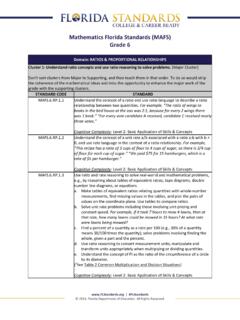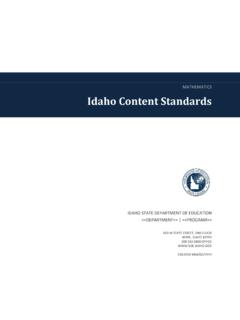Transcription of Grade Six - Virginia Department of Education
1 Mathematics Standards of Learning for Virginia Public Schools September 2016. Grade Six The sixth- Grade standards provide a transition from the emphasis placed on whole number arithmetic in the elementary grades to foundations of algebra. The standards include a focus on rational numbers and operations involving rational numbers. Students will use ratios to compare data sets; recognize decimals, fractions, and percents as ratios ; solve single-step and multistep problems, using positive rational numbers; and gain a foundation in the understanding of and operations with integers. Students will solve problems involving area and perimeter, and begin to graph in a coordinate plane.
2 In addition, students will build on the concept of graphical representation of data developed in the elementary grades and develop concepts regarding measures of center. Students will solve linear equations and inequalities in one variable, and use algebraic terminology. Students will represent proportional relationships using two variables as a precursor to the development of the concept of linear functions. The use of appropriate technology and the interpretation of the results from applying technology tools must be an integral part of teaching, learning, and assessment. While learning mathematics, students will be actively engaged, using concrete materials and appropriate technologies to facilitate problem solving.
3 However, facility in the use of technology shall not be regarded as a substitute for a student's understanding of quantitative and algebraic concepts or for proficiency in basic computations. The acquisition of specialized mathematical vocabulary and language is crucial to a student's understanding and appreciation of the subject and fosters confidence in mathematics communication and problem solving. Problem solving is integrated throughout the content strands. The development of problem-solving skills is a major goal of the mathematics program at every Grade level. The development of skills and problem- solving strategies must be integrated early and continuously into each student's mathematics Education .
4 Number and Number Sense The student will represent relationships between quantities using ratios , and will use a appropriate notations, such as b , a to b, and a:b. The student will a) represent and determine equivalencies among fractions, mixed numbers, decimals, and percents; and b) compare and order positive rational numbers. The student will a) identify and represent integers;. b) compare and order integers; and c) identify and describe absolute value of integers. The student will recognize and represent patterns with whole number exponents and perfect squares. Computation and Estimation The student will a) multiply and divide fractions and mixed numbers.
5 B) solve single-step and multistep practical problems involving addition, subtraction, multiplication, and division of fractions and mixed numbers; and c) solve multistep practical problems involving addition, subtraction, multiplication, and division of decimals. 1. Mathematics Standards of Learning for Virginia Public Schools September 2016. The student will a) add, subtract, multiply, and divide integers;. b) solve practical problems involving operations with integers; and c) simplify numerical expressions involving integers. Measurement and Geometry The student will a) derive (pi);. b) solve problems, including practical problems, involving circumference and area of a circle; and c) solve problems, including practical problems, involving area and perimeter of triangles and rectangles.
6 The student will a) identify the components of the coordinate plane; and b) identify the coordinates of a point and graph ordered pairs in a coordinate plane. The student will determine congruence of segments, angles, and polygons. Probability and Statistics The student, given a practical situation, will a) represent data in a circle graph;. b) make observations and inferences about data represented in a circle graph; and c) compare circle graphs with the same data represented in bar graphs, pictographs, and line plots. The student will a) represent the mean of a data set graphically as the balance point; and b) determine the effect on measures of center when a single value of a data set is added, removed, or changed.
7 Patterns, Functions, and Algebra The student will a) represent a proportional relationship between two quantities, including those arising from practical situations;. b) determine the unit rate of a proportional relationship and use it to find a missing value in a ratio table;. c) determine whether a proportional relationship exists between two quantities; and d) make connections between and among representations of a proportional relationship between two quantities using verbal descriptions, ratio tables, and graphs. The student will solve one-step linear equations in one variable, including practical problems that require the solution of a one-step linear equation in one variable.
8 The student will a) represent a practical situation with a linear inequality in one variable; and b) solve one-step linear inequalities in one variable, involving addition or subtraction, and graph the solution on a number line. 2.















